Zeiss Ikon Contax Camera Repair
A home for your Zeiss Ikon Contax, Contarex or Super Ikonta camera!
- Home
- Information
- Articles
Index
The Contax Vs. Nikon Rangefinder Focusing Mount and Threading Question Solved
Just like the old question about whether it is best to store a camera with the shutter discharged or cocked (best discharged), there has always been the question about the differences between the focusing mount and the focusing helical threading on the Contax and the Nikon Rangefinder cameras. It seemed a good time to thoroughly examine this longstanding question to see what might shake out of it. There are some surprises in the data that has been collected.
The first thing to do is to ruin the myth that Nikon produced 50 mm marked lenses with a 51mm focal length and Zeiss produced Sonnars and Tessars with a 53 mm focal length. The fact is that Nikon has never made any statement to this effect and neither has Zeiss. As a practical matter it just isn't possible for any lens manufacturer to be so precise. Lenses, just like any other manufactured product have tollerances. I've seen hundreds of 50mm f1.5 and 2.0 Sonnars dating from 1932 to 1964 and can say that some of them had an actual focal length greater than 50mm and some were less than 50mm. My experience is that if one calculated the mathematical average of all the actual focal lengths of all the 50mm marked lenses produced by Nikon or Zeiss in a year it would be very close to 50.0 mm. Camera lenses are very complex and are made of a number of separate optical glass elements, each having its own manufactured tolerance. The result is that every lens ever made is a combination with the result the assembled lens is unique; and some are slightly more than 50mm and some are slightly less. Lens making is an art today just as it always has been and it is subject to constant improvement and change.
I purchased a nice old Nikon S Rangefinder camera and removed the focusing mount from it. A Contax IIa camera focusing mount was also obtained. Both were ultrasonically cleaned to make sure there would be no differences in measurements caused by dirt or dust. Here's a picture of them both side by side. The Nikon mount is on the left:
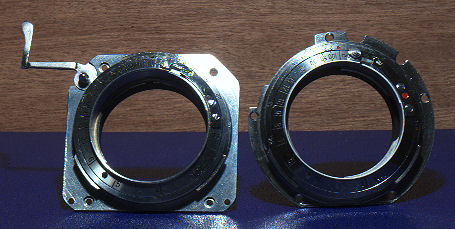
It's easy to see that the Nikon mount has four screw holes on a square and the Contax has five in a pentagonal pattern. Also, the Nikon infinity stop is on the left and the Contax is on the right. These factors make it virtually impossible to put a Nikon mount onto a Contax or a Contax mount onto a Nikon.
Here's a picture of the lens mounts right side up and side by side. You can see that they are exactly the same size above the camera body mount. This makes it clear to see that the 0.31 mm offset is solely due to the fact the Nikon camera body is 0.31 mm thinner than the Contax IIa body.

It seemed the best way to see if there was any difference in thread pitch was to try to put a Nikon male barrel into the Contax female mount and then fit the Contax barrel into the Nikon female mount. It was possible to easily thread the Nikon barrel into the Contax mount. This demonstrates that the pitch of the Nikon mount threads is identical to the Contax. This picture shows the Nikon barrel fully screwed into the Contax mount:
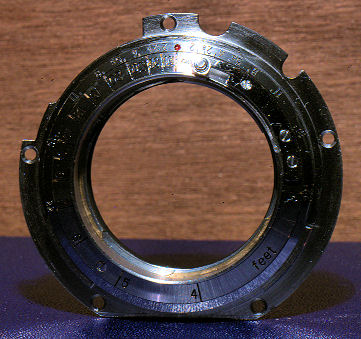
It wasn't possible to screw the Contax barrel into the Nikon mount because there is a difference in the diameter of the barrels which is large enough to prevent this. The Nikon barrel has a diameter of 39.60 mm and the Contax barrel is 40.00 mm in diameter. The tolerances of both the Nikon and the Contax female mounts are close enough so that the Contax barrel will not fit into the Nikon mount. But they both have the same thread pitch and this means that for each degree of rotation of the barrel the barrel of the Nikon and the Contax mount will extend from the mount the same exact distance.
This is a picture of the Nikon and Contax barrels side by side. It's easy to see both have the same thread. The Nikon barrel is on the left:
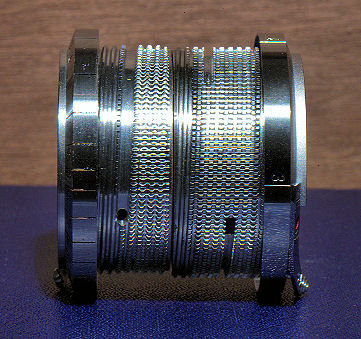
This finding contradicts what had been thought to be true. Up until now the thinking had been that the Nikon and Contax helical thread pitches were different, but this is is not correct. Looking backward with perfect hindsight its easy to see that the thread pitches had to be the same. If they were different then the case would be who got it right, Nikon or Contax? The answer is that both were right and Zeiss figured out the right pitch to use first. But there must be something that explains the difference between the lenses made for the Nikon and the Contax and it turns out to be very simple. The Nikon is a thinner camera than the Contax. It's actually 0.31 mm thinner. This difference was determined using the following method.
Both the Nikon and the Contax lens mounts were put onto camera bodies. Each body was put onto a precision granite measuring block, an empty Sonnar lens mount was put onto the camera, and a precision depth measurement micrometer was used to measure the infinity distance to the focal plane. Here's a picture of the measurement setup with the Nikon S body on the block:
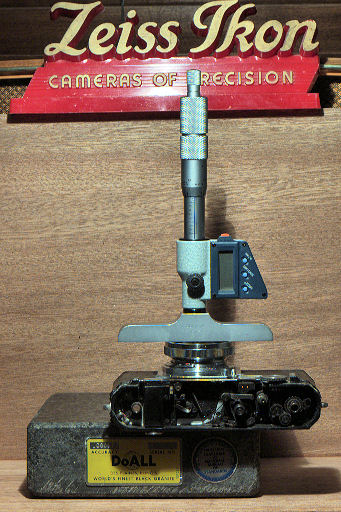
The measurements showed that at infinity focus the Nikon S had a distance of 26.51 mm and the Contax was 26.82. The difference between these is 0.31 mm. This means that if you want to take a Sonnar lens that is adjusted to give good infinity focus on a Contax and use it on a Nikon and get good infinity focus the lens cartridge must be moved outward in the lens mount by a distance of 0.31mm. This 0.31 mm distance is enough to have a visible effect on the photos the camera produces if a Nikor is used on a Contax or a Sonnar is used on a Nikon without being adjusted.
If you take the engraved bezels off of the Nikon barrel and the Contax barrel and put them together there are some differences in the distance engravings. This is a set of five pictures of both barrels set together and rotated from infinity to 3 feet. The Contax bezel is on top::
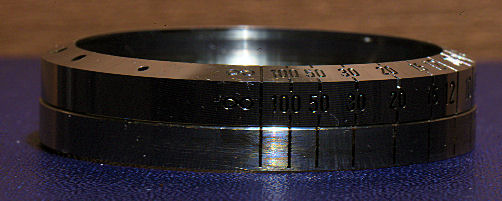
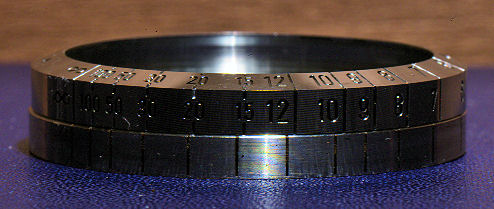
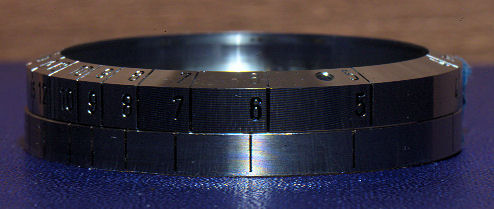
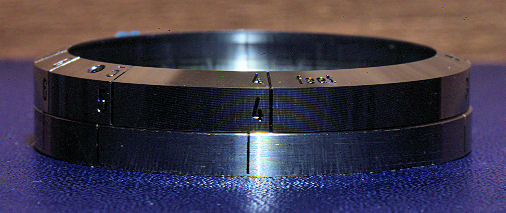
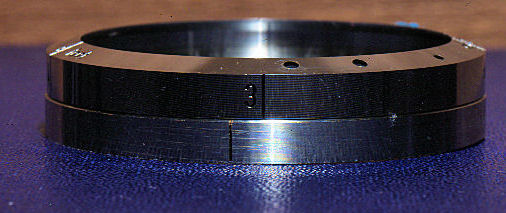
It's plain to see there are differences between the two. It isn't possible to do an exact measurement but the difference is about 25 feet at infinity and decreasing to about an inch at 3 feet.
The next thing to do was to take a series of distance to the focal plane measurements for each camera and at each focus setting. When these are put onto a graph together the result is a very clear demonstration of what is really happening with both cameras:

Note that the data points are for engraved distance markings and the distances for each which are slightly different starting at about 9 feet. I think this difference at close focusing distances, which is different from the infinity offset of 0.31 mm due to camera thickness difference, is due to the difference in the optical glass used in the Nikor and the Sonnar.
My experience with setting the focal point of the Sonnar 50 mm f1.5 lens on Contax cameras is that it is possible to see the focus difference in a difference of about 2 inches around the exact focus point. Using the data from the graph it can be seen that if a Sonnar which is set for good infinity focus on a Contax is used on a Nikon the focus will be off by about 25 feet at infinity, 10 feet at 100 feet and then declining down to about a foot off at close distances. This will be very noticeable.
The conclusion of this work is simply that a Zeiss Contax lens to be used on a Nikon camera must have the lens cartridge moved 0.31 mm further out in the focusing mount and a Nikor lens to be used on a Contax must be moved about 0.31 mm further in. When this is done there will be a slight error in the distance indicated by the engravings on the lens bezel, but the rangefinder will be accurate and the lens will produce sharp images from infinity to close distances.
